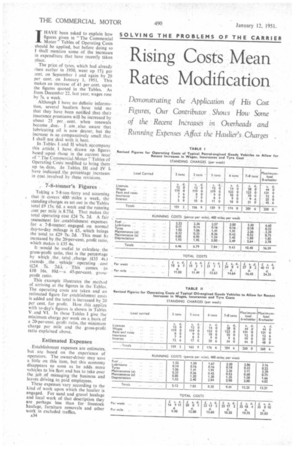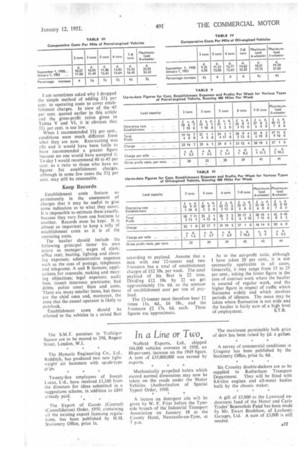I HAVE been asked to explain how figures given in "The
Page 68

Page 71

If you've noticed an error in this article please click here to report it so we can fix it.
Commercial Motor" Tables of Operating Costs should be applied, but before doing so I shall mention some of the increases in expenditure that have recently taken
place. . .
The price. of tyres, which had already risen earlier in 1950, went up 171 per zent. on September 1 and again by 20 per cent. on January I, 1951. This makes an increase of 41 per cent. upon the figures quoted in the Tables. As from December 22. last year, wages rose by 7s. a week.
Although I have no definite information, several hauliers have told me that they have been notified that. their insurance premiums will be increased by about 25 pei. cent, when renewals become .due. I .am . also aware that lubricating oil is now dearer, but the increase is-so comparatively small.that I shall -not deal with it here.
In -Tables I and 11 which accompany this article. I have, drawn up figures based' :upon those in the current issue. of "The commercial-Motor' Tables of Operating COst.s modified to bring them up to.. dater In Tables Ill and IV I. have indicated the percentage increases in cost involved by these revisions.. _ 1-8-tonner's Figures
Taking a 7-8-ton 'lorry and assuming ,
that-it. Covers400Miles a week, the standing charges as Set out in theTables total £9 15s. 6d. a week and the running cost per mile is 8.75d. That makes the total operating cost £24 7s. 2d. A fair assessment for ,establishment expenses for a, 7-8-tonner; engaged, on normal day-to-day mileage is £5, which brings the -total to £29 7s: 2d. This must be increased by the 20Ixr-cent. profit ratio, which makes it £35 4s, It -.would be useful to calculate the gross-profit call°, that is the percentage by which the, total ,charge (£35 4s.) exceeds , the v.ehicle • operating cost (£24 7s. 2th). , This comes to £10 16s. 10d.-a 45-percent, grossprofit ratio,
This example illustrates the method of arriving at the figures in the Tables. The operating costs are taken and an estimated figure for establishment costs is added and the total is increased by 20 per cent, for profit. How this applies with to-day's figures is shown in Tables V and VI. In these Tables I give the minimum charge per week on a, basis of a 20-per-cent. profit ratio,. the minimum charge per mile and the gross-profit ratio explained above,
Estimated Expenses
.Establishment expenses are estimates, but are based on the experience of operators. The owner-driver may save a little on this item, but•this economy disappears so soon as he adds, more vehicles to his fleet and has to take over the job of managing•the business and leaves driving to paid employees.
These expenses vary according to the kind of work upon which the haulier is engaged. For sandand gravel haulage and local work of that description they are perhaps less than for livestock haulage, furniture removals and other work in excluded traffics.
A34 I am sometimes asked why I dropped the simple method of adding 33k per cent. to operating costs to cover establishment charges. In view of the 45 per cent. quoted earlier in this article and the gross-profit ratios given in Tables V and VI, it is obvious that 331 per cent, is too low.
When I recommended 331 per cent., conditions were much different from what they are now. Rate-cutting was rife and it would have been futile to have recommended a greater figure because no one would have accepted it. To-day I would recommend 40 to 45 per cent, as a ratio to those who have no figures for establishment charges, although in some few cases the 33k per cent. may still be reasonable.
Keep Records
Establishment costs . feature so prominently in the assessment of charges that it may be useful to give some indication as to what they cover. It is impossible to estimate them exactly, because they vary from one business to another. Records must be kept. It is almost as important to keep a tally of establishment costs as it is of till: operating costs.
The haulier should include the following principal itemshis own salary as manager; wages of clerk; office rent; heating, lighting and cleanir it expenses; administrative expenses such as the cost. of postage, telephones and telegrams; A and B licences; applications for renewals; making and meeting objections; legal expenses; audit fees; transit insurance premiums; bad debts; police court fines and costs. There arc many smaller items, but these are the chief ones and, moreover, the ones that the casual operator is likely to overlook.
Establishment costs should be allotted to the vehicles in a mixed fleet according to payload. Assume that a man with one '12-tonner and two 5-sonners has a total of establishment charges of £12 10s. per week. The total payload of his fleet is 22 tons.. Dividing £12 10s. by 22 we get approximately 1 ls. 6d. as the amount of establishment cost per ton of payload.
The 12-tonner must therefore bear 12 times I Is. 6d., £6 18s., and the 5-tonners £2 17s. 6d. each. These figures are 'approximate. As to the net-profit ratio, although I have taken 20 per cent., it is not necessarily applicable in all casts. Generally, it may range from 15 to 25 per cent., taking the lower figure in the case of contract work where the haulier is assured of regular work, and the higher figure in respect of traffic which fluctuates widely and which involves periods of idleness. The mean may be taken where fluctuation is not wide and the haulier is fairly sure of a high level of employment. S.T.R.




































































































